After tooth extraction, many people wonder about the best time to get a prosthetic tooth. In fact, if the gums are stable and capable of support, you can choose a dental bridge or removable dentures after about 1-2 months. For dental implant procedures, the appropriate time is usually 2-3 months after extraction, when the jawbone and gums have completely healed. Dental studies indicate that 10–12 weeks post-extraction is the optimal period for restoration, ensuring long-term effectiveness and minimizing complications. Choosing the right time for tooth restoration will help comprehensively restore chewing function and aesthetics.
What Happens If You Don’t Replace a Tooth After Extraction?
Tooth loss due to accidents, old age, cavities, or other oral diseases requiring extraction is a common situation. However, if you don’t replace a tooth after extraction, the answer is YES, there will be serious consequences for your oral and overall health.
At the site of the extracted tooth, the jawbone will be empty, gradually leading to jawbone resorption due to the lack of chewing force. This not only causes difficulty chewing and affects food digestion but also increases the risk of digestive tract diseases.
Tooth loss can also deform the face, especially when chewing forces are uneven, easily forming wrinkles and making the face appear older faster. Furthermore, the remaining teeth will shift into the empty space, causing misalignment, altering the bite, and potentially leading to temporomandibular joint (TMJ) pain.
Specifically, losing a front tooth can cause you to mispronounce words, lisp, or have a whistling sound when speaking. The gap when smiling also greatly impacts aesthetics (oral), causing self-consciousness and limiting social interaction.
As an experienced dentist in the field of dental prosthetics, My Auris advises patients to restore their teeth early after extraction to preserve the jawbone, restore chewing force, protect oral health, and ensure aesthetic factors. Choose reputable dental facilities with highly skilled dental teams to perform tooth restoration safely and effectively.
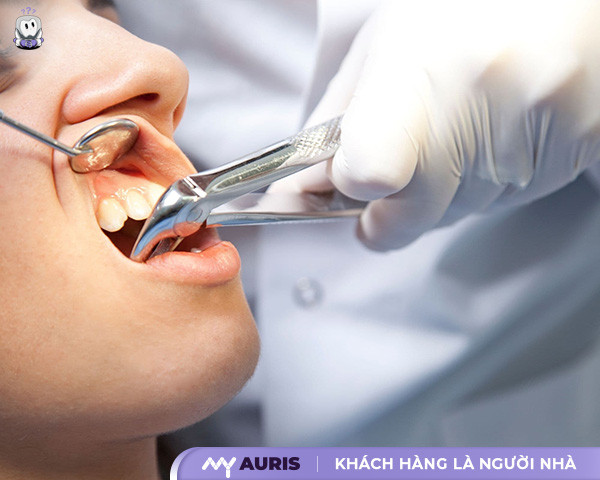
How Long After Tooth Extraction Can You Get Dentures?
How long it takes to replace a tooth after extraction depends on many factors, the most important being the healing condition and the extent of tooth infection before extraction. Typically, after about 7 days, granulation tissue begins to appear in the tooth socket. After about 1-2 months, the soft tissue at the extraction site has largely recovered, but the boundary of the old tooth socket may still be visible on an X-ray of the jaw. It takes 3 to 6 months for the jawbone to fully regenerate to be suitable for fixed prosthetic teeth.
Generally, after 1-2 months post-extraction, patients can opt for flexible restoration solutions such as dental bridges or removable dentures. For implant placement techniques, a waiting period of at least 2-3 months is required. However, in some special cases, immediate implant placement or temporary restoration can be performed right after extraction, if the patient’s constitution is good and there is no infection.
For elderly individuals or large extraction wounds, the healing time will be longer. The dentist will determine the appropriate time to ensure the best tooth restoration results.
To achieve optimal tooth restoration results, in addition to choosing the correct tooth restoration technique and appropriate method, patients need to strictly follow post-extraction care instructions, adhere to a suitable diet, and take medication as prescribed.
Popular Denture Restoration Methods Today
When permanent teeth are lost, tooth restoration is essential to ensure chewing ability, aesthetics, and to maintain facial structure. Currently, there are 3 widely applied methods for prosthetic tooth restoration, each with distinct advantages and disadvantages.
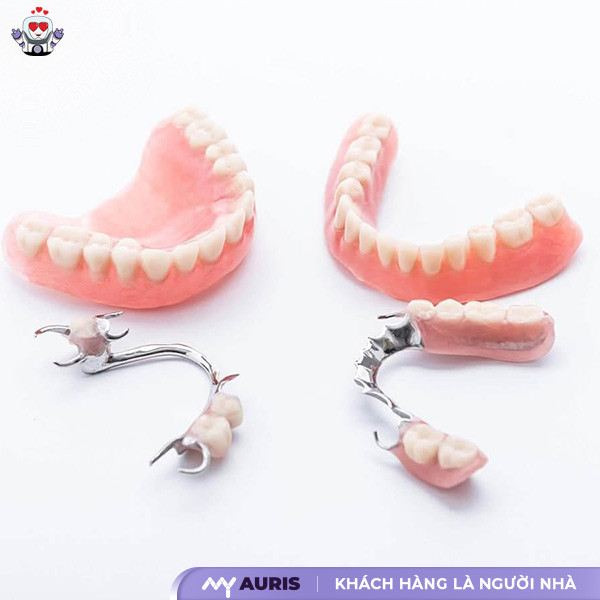
Removable Dentures
Advantages:
- Fast restoration time, low cost, suitable for many people.
- Can be easily removed for daily oral hygiene.
Disadvantages:
- Short lifespan, typically only 3–5 years.
- Limited when eating hard or chewy foods as the dentures can easily fall out.
- Does not prevent jawbone resorption, which over time can lead to changes in facial structure and premature facial aging.
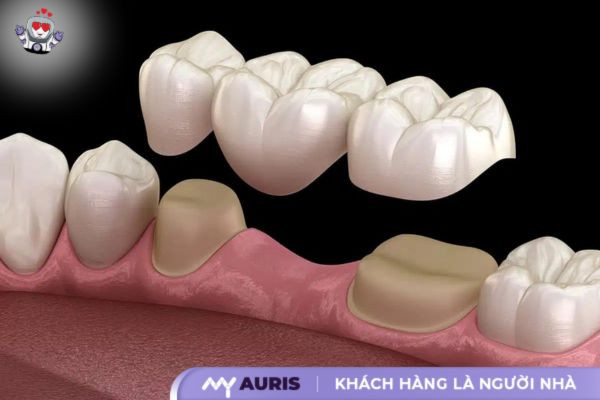
Dental Bridge
Advantages:
- Restores chewing function better than removable dentures.
- Teeth are securely fixed, providing a natural aesthetic appearance.
Disadvantages:
- Requires grinding down healthy natural teeth on both sides to serve as abutments, affecting natural teeth.
- If the technique is not precise, it can easily damage both natural and prosthetic teeth.
- Lifespan of 7–10 years and does not prevent jawbone resorption, leading to premature facial aging.
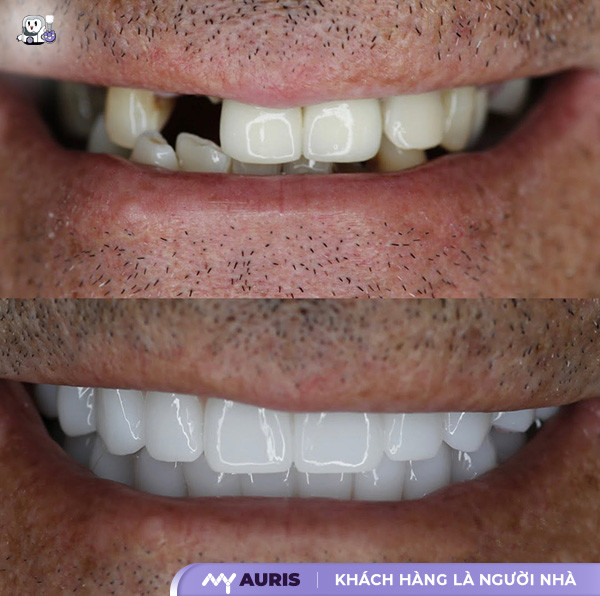
Dental Implant
Dental Implant is considered the most modern and optimal prosthetic tooth solution available today, especially suitable for those who have lost teeth for a long time.
Advantages:
- Restores almost perfectly both chewing function and aesthetics, achieving up to 99% compared to natural teeth.
- Requires only one procedure, but the lifespan can last a lifetime, saving costs in the long run.
- It is the only method capable of preventing jawbone resorption, protecting facial structure, and limiting facial aging.
Disadvantages:
- Currently, implants have almost no significant disadvantages if performed with the correct technique and properly cared for.
Frequently Asked Questions
How long after a front tooth extraction can it be replaced?
After a front tooth extraction, if the jawbone and gums are healthy enough, you can get an immediate dental implant to replace the lost tooth. If the tooth was extracted previously, the ideal time for tooth replacement ranges from 1–2 months, during which removable dentures or a dental bridge can be used once the gums are stable. For fixed prosthetic teeth, the most suitable time is after 2–3 months, when the soft tissue and bone around the extraction site have fully recovered. Choosing the appropriate tooth replacement method should be based on oral health status, ensuring long-term aesthetics and chewing function.
How long after a molar extraction can it be replaced?
After a molar extraction, the ideal time for tooth replacement depends on the healing rate and the stability of the jawbone and gums. Generally, 1–2 months post-extraction, patients can use a dental bridge or removable dentures as a temporary solution. However, if choosing a dental implant – a type of fixed prosthetic tooth capable of withstanding strong chewing forces – it’s advisable to wait 2–3 months or ideally after 3 months to ensure complete recovery of the bone and gum area. This recovery time is necessary for the implant post to integrate securely into the jawbone, providing long-term effectiveness and stability for chewing function.
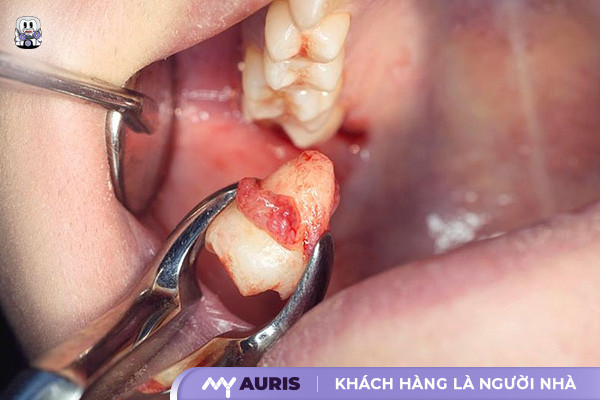
What happens if a molar is not replaced after extraction?
Not replacing a molar after extraction is a common mistake but one that carries many serious consequences. After tooth loss, the unrestored empty space will cause adjacent teeth to tilt and shift, leading to malocclusion and an aesthetically unpleasing face. Additionally, reduced chewing ability affects digestion, and in the long term, causes jawbone resorption, leading to sunken cheeks, wrinkles, sagging skin, and an older-than-age appearance. Moreover, the empty space from the missing tooth creates conditions for bacteria to infiltrate, easily leading to dangerous oral diseases.
How long after tooth extraction can you get a dental bridge?
After tooth extraction, the body needs time for the jawbone and gums to heal. According to dental recommendations, approximately 3 months after tooth extraction is the appropriate time to perform permanent ceramic tooth restoration using a dental bridge or dental implant method.
At this point, the gum tissue is stable, and the jawbone is strong enough to support the implant post or bridge, helping the prosthetic tooth restoration process to be safe, effective, and to reduce the risk of complications. Choosing the right time not only ensures aesthetics but also extends the lifespan of the restored ceramic teeth.
How long after tooth extraction can you get dentures?
After tooth extraction, the time for new tooth restoration will depend on the degree of healing, the location of the extracted tooth, the patient’s overall health, and the chosen tooth restoration method.
Typically, after 30–60 days, patients can undergo temporary restoration with a dental bridge or removable dentures. Meanwhile, for fixed dental implant placement, patients should wait approximately 60–90 days, when the gum tissue and jawbone have fully recovered.
However, this timeline can vary depending on individual clinical cases. To accurately determine the time for tooth replacement, patients need to be examined by a highly specialized dentist in the field of dental restoration.
Do molars need to be replaced after extraction?
Molars play a crucial role in ensuring chewing function and maintaining overall oral health. When a molar is extracted, if it is not replaced promptly, you may face jawbone resorption, teeth shifting, an increased risk of oral diseases, serious impact on facial structure, and reduced facial aesthetics.
Replacing molars not only helps restore effective chewing function but also prevents many long-term complications. This is an important step to help you maintain healthy and balanced teeth, while preserving a natural appearance over time.
When is it necessary to extract a permanent tooth?
Permanent tooth extraction is a minor dental surgery only indicated in cases where the tooth cannot be preserved. If severe decay makes fillings ineffective, or the tooth structure is badly damaged, the pulp is dead, leading to periapical inflammation that cannot be treated with root canal therapy, then extraction is necessary. Additionally, severely loose teeth that make chewing difficult, or broken teeth with only root fragments remaining, also need to be extracted to avoid complications.
Common causes leading to this condition include: poor oral hygiene, oral diseases, old age leading to weakened teeth, or accidents causing severe damage. These factors make teeth prone to premature loss if not intervened promptly.





